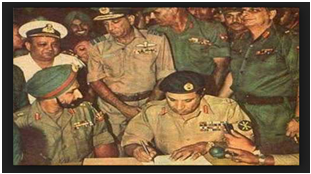THE 1971 WAR
When two countries fought for the birth of a new country
We are discussing this
in the context of the 1971 war between India and Pakistan. There are a wide
number of circumstances that resulted into the war call. Amidst those stressful times between India
and Pakistan, this was the only war which did not include Kashmir.
The situation started taking a suicidal form, when the East
Pakistan (now Bangladesh) was campaigning for the recognition of Bengali language as one of the official
languages. Many refugees from East Pakistan
came to India to seek shelters to save their lives from the Pakistani
brutalities and hostilities.
India unwantedly became a part of this conflict on 15 May,
when it started aiding and training the Mukti Bahini fighters of East Pakistan. India also launched a global diplomatic offensive to help create
Bangladesh. India’s army took over the
responsibility of the operations to be
carried out against West Pakistan. On Dec 3, 1971 Pakistan Air Force launched
aerial attacks on some of the major
airbases at India. It was then when India called out for a war in
the wee hours of Dec 4. The war lasted
for 13 days causing havocs in both the kingdoms. India
not only gave Pakistan a thrashing defeat, but also made more than 90,000
Pakistan armymen surrender on Dec 16. Subsequently, Bangladesh celebrates this
day as the victory day, remarking
its liberty from Pakistan.
Lt-Gen A A K Niazi signing the surrender before Lt-Gen
Jagjit Singh.
Our Indian Air Force and Navy played very significant roles in this war and fought bravely in the sky and on the waves. Bombing of the Karachi port, destruction of Pakistani submarine, PNS Ghazi, operation Python remains the highlights of our Naval performance in the 1971 war. Nirmaljit Singh Sekhon, a brave Ambala based flying officer took on six PAF sabre jets before hitting two of them, lost his life in the battle, and was later awarded the Paramveer Chakra (India's highest military decoration). PAF could not succeed in destroying the Indian aircrafts on the pre-emptive strikes on Dec 3, while IAF destroyed a notable number of PAF aircrafts during the 13-day conflict. IAF bombed the Peshawar, Chaklala and Kohat airfields of Pakistan. It was on March 26, 1971 that Bangladesh got a recognition as an independent nation.
Nirmaljit
Singh Sekhon(PVC)
Following are the remarkable aspects of the war:
1. Battle
of Longewala
2. Battle
of basantar
3.
Operation
Python
4.
Battle
of Kushtia
5.
Battle
of Hilli
6.
Battle
of Sylhet
7.
Battle
of Garibpur
8.
India’s
defeat at the Chhamb
- India and Pakistan waged a war for the first time post independence, when the Kashmir was yet to decide which independent state to join. The war halted on 1 Jan 1949. The two countries signed an UN based agreement, according to which India got 65% of the Kashmir territory.
- The second Indo-Pak war took place in 1965, which lasted for 3 weeks.
- The 1999 Kargil war is an important asset in the history of the relationships between the two countries. India responded by launching air strikes against Pakistan when they crossed their borders from Kashmir.
Even today after so many years of
independence, the relations between the two countries continues to be of
inter-tensions and rivalry. With the onset of 2017, it seems unpredictable to
define the forthcoming shifts in the relationships of the two countries. After
going through the history of the countries, we can easily conclude that the two
countries could never improve their mutual understandings even though they took
birth simultaneously.





Comments
Post a Comment